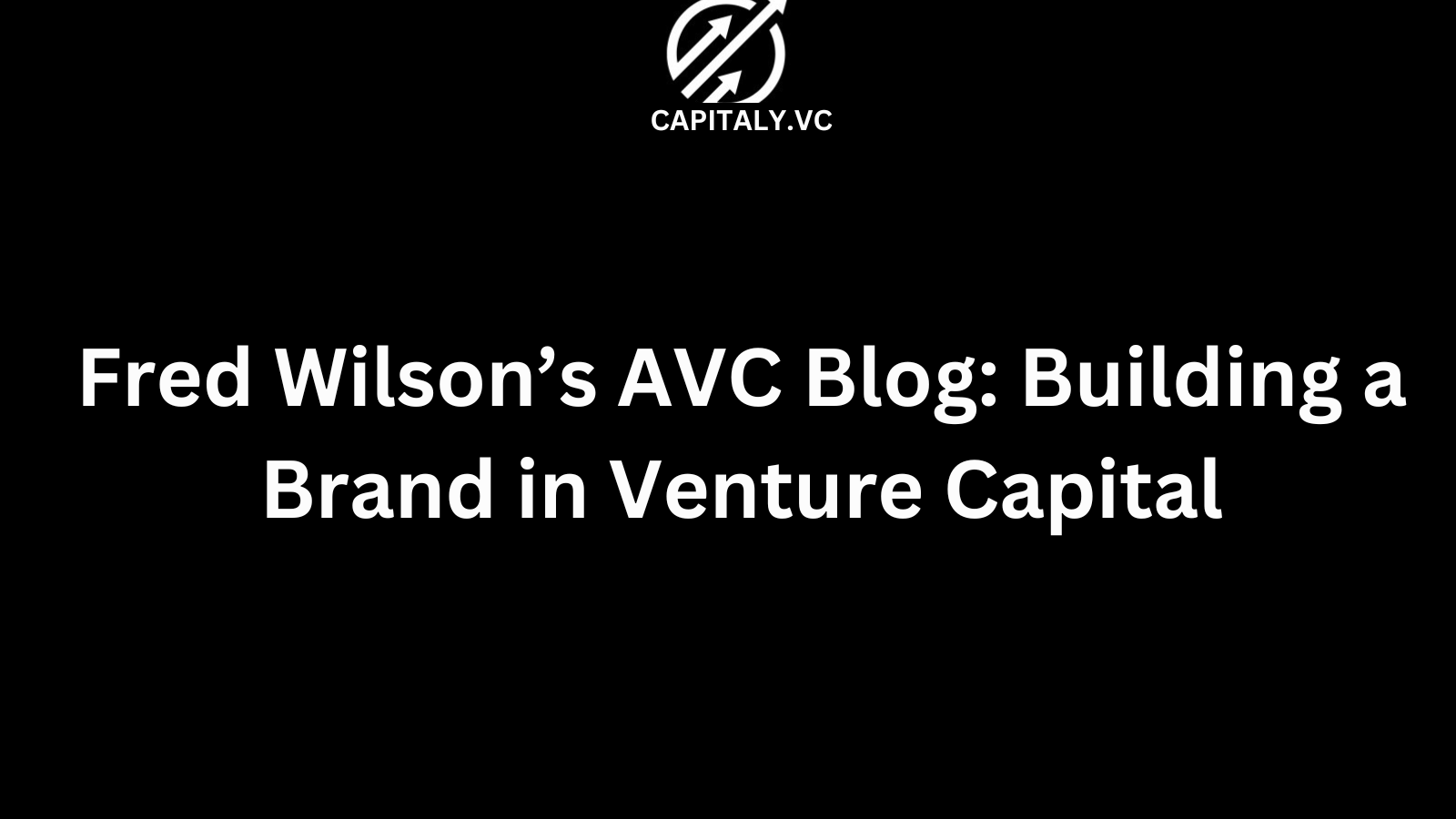Fred Wilson’s AVC Blog: Building a Brand in Venture Capital
Fred Wilson’s AVC Blog: Building a Brand in Venture Capital

Most VCs talk about brand.
Fred Wilson built one—with just a blog.
The AVC blog isn’t just well-known in tech—it’s a blueprint for how content can drive deal flow, build trust, and shape a legacy in venture capital.
This post breaks down what made AVC so effective—and how founders and investors alike can apply the same playbook.

Who is Fred Wilson?
Fred Wilson is the co-founder of Union Square Ventures.
He’s invested early in hits like Twitter, Etsy, Tumblr, and Coinbase.
But beyond the portfolio, he’s known for something rarer: daily blogging for nearly 20 years.
The AVC Blog’s Influence on VC SEO
Fred didn’t build his brand on PR or LinkedIn.
He wrote. Every day.
That writing became a powerful SEO engine. AVC ranks for hundreds of high-intent terms founders search.
You can do the same.
Here’s how: Best CRM Integrations for Startup Fundraising breaks down CRM and content alignment to build inbound traffic and trust.
Key Ideas from Fred Wilson’s Most Popular Posts
Some of Fred’s most enduring posts include:
- “MBA Mondays” – a free crash course on startup finance
- The Management Series – on hiring, org design, and CEO mistakes
- Crypto posts from 2013–2016 – ahead of the curve
He built trust through clarity and consistency, not hype.
How Fred Wilson Uses Blogging to Build VC Deals
Fred’s blog wasn’t marketing.
It was pre-diligence.
Founders read his posts for months—sometimes years—before pitching.
When they did, they came in warm.
You can do the same with your startup: What Are the Most Effective Methods to Raise Capital Quickly? shows how founders build investor trust at scale.
Writing for Founders: Fred’s Communication Style
Fred writes like he talks:
- No buzzwords
- Short paragraphs
- One idea per post
It’s founder-friendly writing that respects your time.
Fred Wilson on Venture Capital Metrics
Forget IRR and TVPI—Fred prefers real-world explanations:
“Our job is to turn $1 into $10 over a decade.”
He taught founders how to speak VC without sounding like a VC.
Using LLMs to Track Fred Wilson’s Content Trends
LLMs can now:
- Analyze tone shifts over 20 years
- Surface patterns in investment themes
- Predict future trends based on past topics
Want to see how AI is shaping fundraising today?
Read How Predictive AI Is Transforming Venture Capital in 2025.
Understanding Startup Valuation through AVC
Fred’s view: Valuation = Story + Timing + Market Belief
He doesn’t sugarcoat it.
Valuation is a function of risk, momentum, and conviction—not just spreadsheets.
For a valuation guide, read Series A Valuation: How to Determine Your Startup’s Worth.
Fred Wilson’s Tips for New Entrepreneurs
Top themes:
- Start with a small problem, not a big vision
- Write your thoughts—it sharpens strategy
- Avoid over-raising—it dilutes speed and control
Raise Capital Like a Pro walks you through these principles in today’s environment.
The Role of Transparency in Fred’s Content
Fred doesn’t hide failures.
He’s shared:
- Missed deals
- Bad calls
- Founder fallouts
That candor made him human—and trustworthy.
A similar tone drives Secret Sauce to Funding Success Revealed Inside—an honest post that breaks the fourth wall of capital raising.
How Fred Wilson Balances Data and Storytelling
Each AVC post has a rhythm:
anecdote → insight → takeaway
He makes finance feel personal.
He makes startup pain feel universal.
SEO Keywords Common in Fred’s Blog
Fred ranks for:
- “Convertible notes vs SAFEs”
- “Startup CEO compensation”
- “How to raise a seed round”
Why?
Because he answers what founders actually ask.
Not what VCs want to hear themselves say.
Fred Wilson’s Views on Emerging Technologies
Fred doesn’t chase trends.
He tests convictions.
He was writing about:
- Web3 in 2013
- AI’s risks in 2016
- Creator economy in 2018
For modern valuation frameworks in emerging tech, read AI Startup Valuations – The Reality Check You Need for Fundraising Success.
The Impact of AVC on the VC Community
Fred made it okay for VCs to blog.
Before AVC, the VC playbook was closed.
After AVC?
Transparency became table stakes.
How to Create Engaging VC Content Like Fred Wilson
Here’s the playbook:
- Write daily or weekly
- Answer real founder questions
- Share more than you sell
- Don’t optimize for virality—optimize for trust
Want examples of this in action?
See How VCs See Your Startup – Insights Into Venture Capital Perspectives.
FAQs
1. Why is Fred Wilson’s blog so respected?
Because it’s consistent, founder-focused, and transparent.
2. Does Fred still write every day?
Not daily now, but his archive spans 20+ years.
3. What’s the most famous AVC content series?
MBA Mondays—a go-to guide for startup finance.
4. Is AVC monetized?
No. It builds reputation, not revenue.
5. Can founders apply Fred’s approach?
Yes—content can build founder-brand credibility fast.
6. What platform does AVC use?
WordPress. Simple and durable.
7. What’s Fred’s top advice for new founders?
Solve real problems. Be lean. Stay authentic.
8. How does AVC affect deal flow?
It brings warm inbound leads from aligned founders.
9. What topics does Fred avoid?
Hype. He avoids trends without long-term value.
10. How can I follow Fred’s thinking today?
Start with his archives and follow AVC for updates.
Conclusion
Fred Wilson’s AVC blog proves you don’t need ads or funding buzz to build a powerful VC brand.
You need ideas.
Consistency.
And the courage to be real in public.
Want to attract VCs who think like Fred—or become one?
Subscribe to Capitaly.vc to raise capital at the speed of AI.



.png)